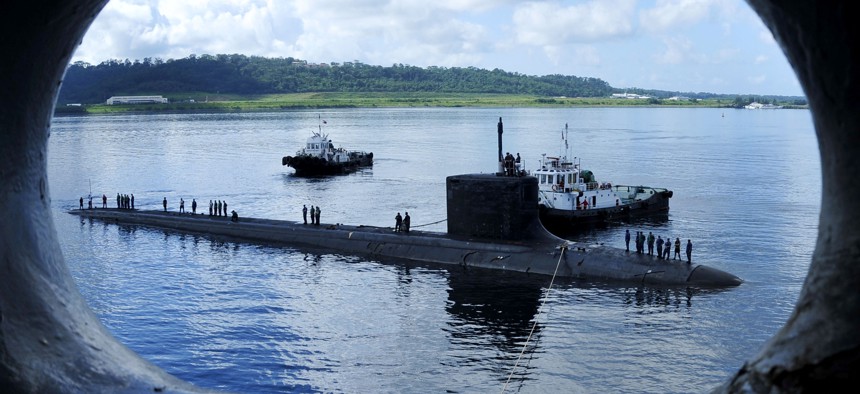
In this 2011 file photo, the Virginia-class fast attack submarine USS Texas (SSN 775) executes a tended mooring alongside submarine tender USS Emory S Land (AS 39) in Subic Bay, Philippines. U.S. Navy / Mass Communication Specialist 2nd Class Chris Williamson
The US Navy Should Start Weaning its Reactors off Bomb-Grade Uranium
Most of the world's reactors use low-enriched uranium. There are at least three good reasons the U.S. fleet should as well.
It’s not often that a Navy Secretary declines money from Congress, but that’s what Richard Spencer is doing with $30 million that lawmakers want him to spend on developing a new type of nuclear propulsion system. Mr. Spencer should reconsider — for the good of the Navy, nonproliferation efforts, and national security.
At issue is the uranium that fuels naval nuclear reactors, which propel dozens of U.S. aircraft carriers and submarines. Unlike the low-enriched uranium that powers our country’s nuclear power plants (and warships of China and France), the U.S. Navy uses highly enriched uranium — identical to the stuff in our nuclear weapons.
Three big risks arise from this. First, we are running out of such bomb-grade uranium for the Navy, and don’t have a factory to make more. The government says the Navy has a 50-year supply – less, if consumption increases. The last high-enrichment facility shut down in 1992, and a new one would take many years to build and would face controversy since it could undermine arms control and nonproliferation. The Navy simply cannot be sure that domestic politics in a few decades will allow production of weapons-grade nuclear material.
The second danger is nuclear terrorism. Each year, two tons of bomb-grade uranium are trucked from a government facility in South Carolina to private plants in Tennessee and Virginia to make the Navy’s nuclear fuel. If just one percent of this annual throughput were stolen – in transit, or at the two commercial facilities that lack federal protection – it would be sufficient for a terrorist nuclear weapon. In 1965, highly enriched uranium went missing from a Navy fuel plant near Pittsburgh and reportedly wound up in Israel’s arsenal. Heaven forbid if the next culprit is an Islamist group with nuclear ambitions.
A third worry is that the Navy’s use of bomb-grade fuel establishes a precedent, opening a backdoor for Iran and other countries to acquire nuclear weapons. Under the Nuclear Non-Proliferation Treaty, safeguards agreements regrettably permit countries to block inspection of nuclear material designated for naval fuel. Thus, a country can produce highly enriched uranium, citing a naval need, then remove it from inspection and illicitly build a bomb. In December 2016, Iran’s President Hassan Rouhani ordered the development of naval reactors that Iranian officials say require highly enriched uranium. Washington cannot rebut this so long as its own Navy uses such uranium.
The good news is that the U.S. National Nuclear Security Administration believes it can develop less risky fuel for future naval vessels. A 2016 report to Congress says an “advanced fuel system could allow use of low-enriched uranium fuel with minimized impact on reactor lifetime, size, and ship costs,” which “could have positive implications from a national security standpoint by creating a practical alternative to highly enriched uranium reactors.”
Congress responded by authorizing $5 million annually on a bipartisan basis over the past three years, even without a Navy request. However, legislators want the Navy to signal support before they provide more substantial funding.
That is why Congress issued an invitation to the Navy Secretary in the defense bill signed by President Trump in December. The law says “an additional $30 million may be made available” for “low-enriched uranium activities and research and development,” but only if the Secretaries of Navy and Energy submit a long overdue determination to Congress that the project should proceed. Since the Energy Department defers to the military’s expertise on naval propulsion, the decision is in the hands of the Navy Secretary.
Why does Spencer hesitate? Because Navy old-timers are used to highly enriched uranium fuel and don’t want to switch – despite risks of proliferation, terrorism, and running out of fuel. Yet the precise reason we have a civilian Secretary is to see the bigger picture.
If Spencer gives Congress the green light, he could also avoid disbanding the Navy’s world-class engineering team, whose recent work designing a ballistic missile submarine is drawing to a close without further funding to employ them. As the U.S. Office of Naval Reactors warned in a 2014 report to Congress: “Development of an advanced fuel system would help maintain the unique naval nuclear technology base… If these essential capabilities are lost, then development of an advanced fuel system will become impractical.”
As Elvis sang, “it’s now or never.” The Navy still has the expertise to develop the lower-risk fuel, and Congress still wants to provide the funding. Before one or both of those evaporates, the Secretary should sign off on this initiative that could become a lasting legacy.



